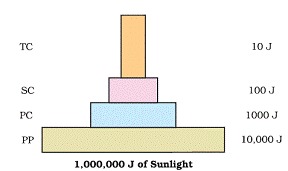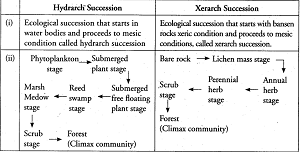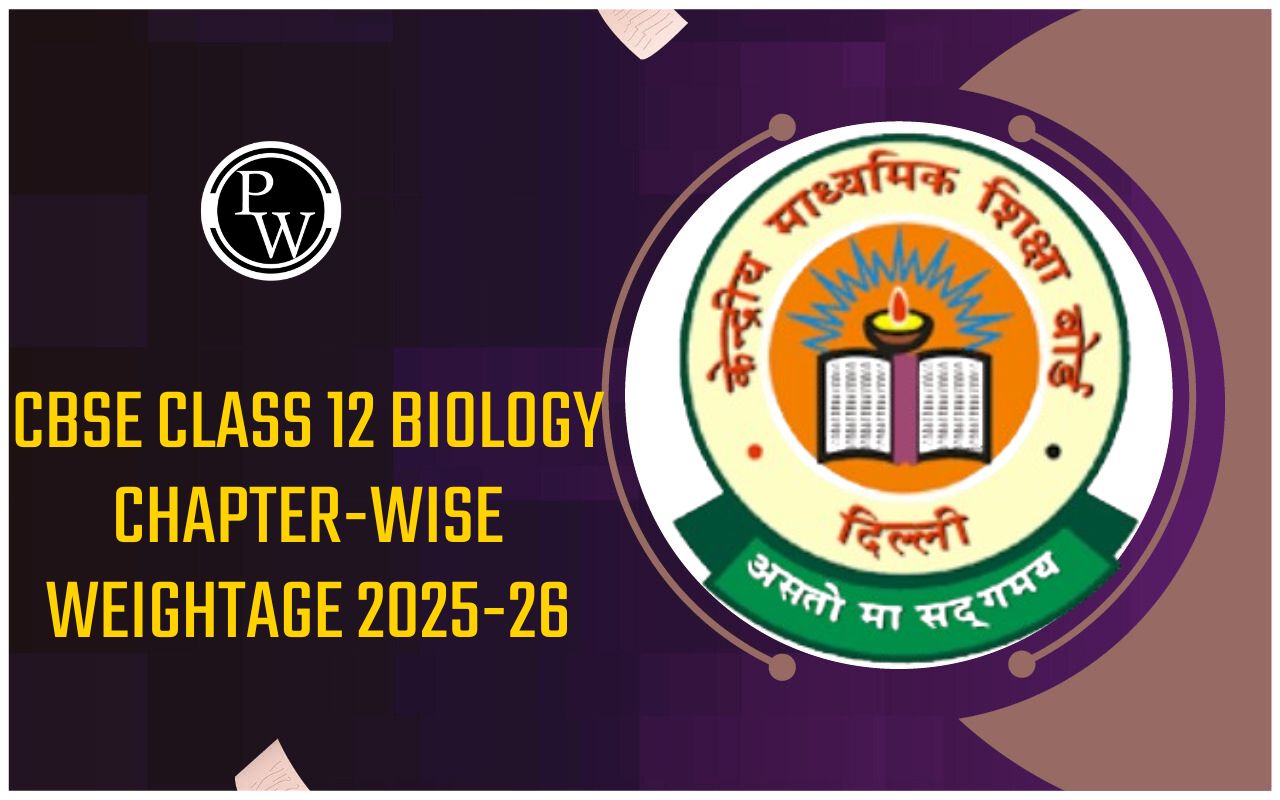
CBSE Class 12 Biology Notes Chapter 14: These notes on Chapter 14 Ecosystem are important for students preparing for their CBSE Class 12 board exams. They provide a detailed overview of ecosystems, emphasizing the intricate relationships between living organisms and their physical environment.
By studying these notes students will gain valuable insights into ecological principles which will not only help in their exam preparation but also enhance their understanding of environmental issues, contributing positively to society and laying a solid foundation for their future studies in biology and related fields.CBSE Class 12 Biology Notes Chapter 14 Ecosystem Overview
These notes on Chapter 14 Ecosystem are prepared by subject experts of Physics Wallah ensuring that students receive accurate and insightful information for their CBSE Class 12 board exams. By using these notes students can develop a solid foundation in ecology which is important for both their exams and their future studies in biological sciences.CBSE Class 12 Biology Notes Chapter 14 PDF Download
The PDF link for the CBSE Class 12 Biology Notes on Chapter 14 Ecosystem is available below. This resource provides a clear and detailed look at important ideas related to ecosystems such as how energy flows, how nutrients cycle and how different organisms interact in their environments. Students can easily download the PDF to help them prepare for their exams. With well-organized content and simple explanations these notes are a great study resource for understanding the relationships in nature and improving knowledge of biology. Be sure to check out this helpful resource for your CBSE Class 12 biology studies.CBSE Class 12 Biology Notes Chapter 14 Ecosystem PDF
CBSE Class 12 Biology Notes Chapter 14 Ecosystem
Below we have provided CBSE Class 12 Biology Notes Chapter 14 Ecosystem-
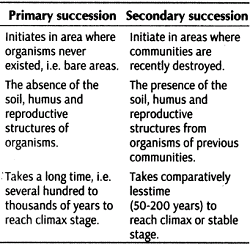
Nutrient Cycling
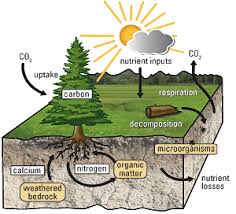 Nutrient cycling refers to the movement of nutrient elements through various components of an ecosystem. This process is also known as biogeochemical cycling. There are two main types of nutrient cycles:
Nutrient cycling refers to the movement of nutrient elements through various components of an ecosystem. This process is also known as biogeochemical cycling. There are two main types of nutrient cycles:
- Gaseous Cycles : These nutrients exist in the atmosphere.
- Sedimentary Cycles : These nutrients are found in the Earth's crust.
Carbon Cycle
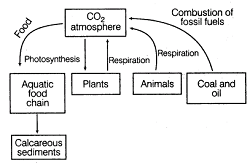 The carbon cycle involves the movement of carbon through the atmosphere, oceans, and living and dead organisms. Most carbon is fixed by plants through photosynthesis, where they convert carbon dioxide (CO₂) from the atmosphere into organic matter. This carbon returns to the atmosphere during respiration by living organisms. Carbon is released into the atmosphere through various activities such as burning wood, forest fires, the combustion of organic matter and fossil fuels, and volcanic eruptions.
The carbon cycle involves the movement of carbon through the atmosphere, oceans, and living and dead organisms. Most carbon is fixed by plants through photosynthesis, where they convert carbon dioxide (CO₂) from the atmosphere into organic matter. This carbon returns to the atmosphere during respiration by living organisms. Carbon is released into the atmosphere through various activities such as burning wood, forest fires, the combustion of organic matter and fossil fuels, and volcanic eruptions.
Phosphorus Cycle
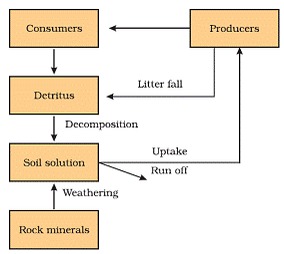 The natural reservoir of phosphorus is found in rocks, where it exists in the form of phosphates. When rocks weather, small amounts of phosphates dissolve in soil and are absorbed by plant roots. The waste products from dead organisms are decomposed by bacteria, which release phosphorus back into the environment. Unlike carbon, the gaseous exchange of phosphorus between organisms and the environment is minimal.
The natural reservoir of phosphorus is found in rocks, where it exists in the form of phosphates. When rocks weather, small amounts of phosphates dissolve in soil and are absorbed by plant roots. The waste products from dead organisms are decomposed by bacteria, which release phosphorus back into the environment. Unlike carbon, the gaseous exchange of phosphorus between organisms and the environment is minimal.
Ecosystem Services
Ecosystem services are the benefits provided by ecosystem processes. These services include:- Purifying air and water in healthy forest ecosystems
- Mitigating floods and droughts
- Cycling nutrients
- Generating fertile soil
- Providing habitats for wildlife
- Maintaining biodiversity
Benefits of CBSE Class 12 Biology Notes Chapter 14 Ecosystem
- Comprehensive Understanding : These notes provide a detailed overview of ecosystems, covering essential concepts such as energy flow, nutrient cycling and ecological pyramids.
- Exam Preparation : With clear explanations and structured content these notes are an effective study resource for board exams, ensuring that students can revise efficiently and confidently.
- Real-World Relevance : Understanding ecosystems and their functions helps students appreciate the importance of biodiversity and the role of humans in maintaining ecological balance.
- Integration of Concepts : The notes emphasize the interconnectedness of biological concepts, allowing students to see how different topics in biology are related enhancing their overall understanding of the subject.
- Boosts Analytical Skills : By studying ecosystems, students develop critical thinking and analytical skills as they learn to interpret ecological data and understand complex environmental issues.
CBSE Class 12 Biology Notes Chapter 14 FAQs
What is an ecosystem?
An ecosystem is a community of living organisms (plants, animals and microorganisms) interacting with each other and their physical environment (soil, water and air) in a specific area.
What are the two main types of ecosystems?
The two main types of ecosystems are terrestrial ecosystems (like forests, grasslands and deserts) and aquatic ecosystems (such as ponds, lakes, rivers and oceans).
What are biotic and abiotic factors?
Biotic factors are the living components of an ecosystem, including plants, animals, and microorganisms. Abiotic factors are the non-living elements, such as sunlight, temperature, water, soil and nutrients.
What is food chain and food web?
A food chain is a linear sequence of organisms where each organism is eaten by the next in the chain, showing how energy and nutrients flow through an ecosystem. A food web is a complex network of interconnected food chains, illustrating the multiple feeding relationships among organisms in an ecosystem.
What are trophic levels?
Trophic levels refer to the different positions that organisms occupy in a food chain. The primary level consists of producers (plants), the secondary level includes herbivores and subsequent levels consist of carnivores and top predators.
🔥 Trending Blogs
Talk to a counsellorHave doubts? Our support team will be happy to assist you!

Check out these Related Articles
Free Learning Resources
PW Books
Notes (Class 10-12)
PW Study Materials
Notes (Class 6-9)
Ncert Solutions
Govt Exams
Class 6th to 12th Online Courses
Govt Job Exams Courses
UPSC Coaching
Defence Exam Coaching
Gate Exam Coaching
Other Exams
Know about Physics Wallah
Physics Wallah is an Indian edtech platform that provides accessible & comprehensive learning experiences to students from Class 6th to postgraduate level. We also provide extensive NCERT solutions, sample paper, NEET, JEE Mains, BITSAT previous year papers & more such resources to students. Physics Wallah also caters to over 3.5 million registered students and over 78 lakh+ Youtube subscribers with 4.8 rating on its app.
We Stand Out because
We provide students with intensive courses with India’s qualified & experienced faculties & mentors. PW strives to make the learning experience comprehensive and accessible for students of all sections of society. We believe in empowering every single student who couldn't dream of a good career in engineering and medical field earlier.
Our Key Focus Areas
Physics Wallah's main focus is to make the learning experience as economical as possible for all students. With our affordable courses like Lakshya, Udaan and Arjuna and many others, we have been able to provide a platform for lakhs of aspirants. From providing Chemistry, Maths, Physics formula to giving e-books of eminent authors like RD Sharma, RS Aggarwal and Lakhmir Singh, PW focuses on every single student's need for preparation.
What Makes Us Different
Physics Wallah strives to develop a comprehensive pedagogical structure for students, where they get a state-of-the-art learning experience with study material and resources. Apart from catering students preparing for JEE Mains and NEET, PW also provides study material for each state board like Uttar Pradesh, Bihar, and others
Copyright © 2025 Physicswallah Limited All rights reserved.
Get App
